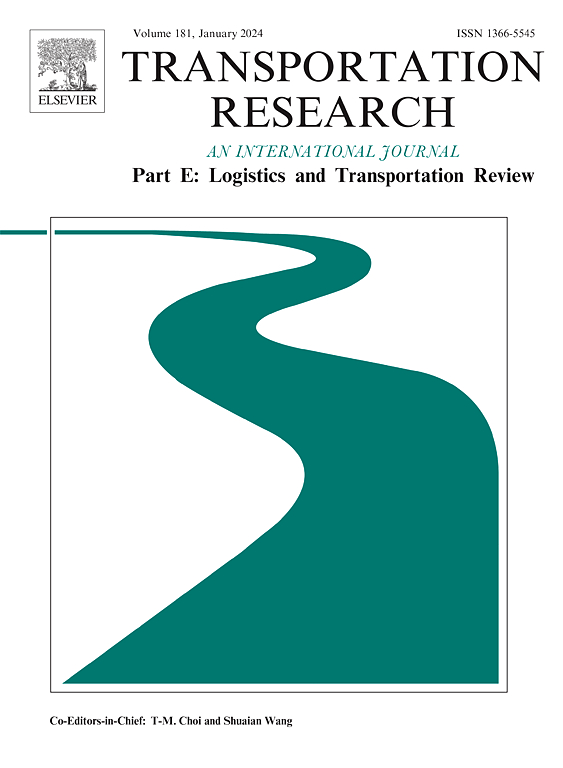B2C和C2C网约车平台在有无市场聚合的情况下表现如何:理论分析
IF 8.8
1区 工程技术
Q1 ECONOMICS
Transportation Research Part E-Logistics and Transportation Review
Pub Date : 2025-10-10
DOI:10.1016/j.tre.2025.104450
引用次数: 0
摘要
最近,第三方聚合平台快速增长,这些平台同时整合了叫车公司和旅行者。旅客在聚合平台上可以选择一家或多家公司,聚合平台会从被选择的公司中选择最优匹配的车辆提供服务。公司聚合是指独立的网约车公司接入并接受聚合平台调度的过程。公司聚集是不可逆转的市场趋势。本研究旨在探讨不同类型的公司聚集对市场中多个利益相关者及其决策的影响。乘客出行选择和拼车公司之间的竞争互动进行了建模,并随后通过数值模拟进行了验证。明确地合并了两种流行的业务模式,即企业对消费者(B2C)和客户对客户(C2C)。然后在三种不同的情景下研究公司聚集的影响:(i) B2C公司之间的聚集,(ii) C2C公司之间的聚集,以及(iii) B2C和C2C公司同时聚集。理论分析表明,在一定条件下,三种聚合方案都能降低出行成本,增加总需求。数值实验首先评价了固定定价下公司聚集的市场效率,从而验证了理论分析的结论。差旅费用最多可减少9.6%。然而,合并可能会降低一些公司的利润。因此,本研究探讨了聚合对公司定价策略和利润变化的影响。数值实验表明,聚合企业只有在一定范围内进行定价合作,才能实现双赢。本研究为不同类型的公司在公司合并后制定管理战略提供了参考。本文章由计算机程序翻译,如有差异,请以英文原文为准。
How do B2C and C2C ride-sourcing platforms perform with and without market aggregation: Theoretical analysis
Recently, there has been a rapid growth in third-party aggregation platforms that simultaneously integrate ride-sourcing companies and travelers. Travelers on the aggregation platform can select one or more companies, and the aggregation platform will choose the optimal matching vehicle from the chosen companies to provide services. Company aggregation refers to the process through which independent ride-sourcing companies access and accept dispatching from aggregation platforms. Company aggregation is an irreversible market trend. This study aims to explore the impact of different types of company aggregation on multiple stakeholders and their decisions in the market. Passenger travel choices and competitive interactions among ride-sourcing companies are modeled and subsequently validated through numerical simulations. Two prevailing business models, business-to-consumer (B2C) and customer-to-customer (C2C), are explicitly incorporated. The impacts of company aggregation are then examined under three distinct scenarios: (i) aggregation among B2C companies, (ii) aggregation among C2C companies, and (iii) simultaneous aggregation encompassing both B2C and C2C companies. Theoretical analysis indicates that under certain conditions, all three aggregation scenarios can reduce travel costs and increase total demand. The numerical experiments first evaluates the market efficiency of company aggregation under fixed pricing, thereby verifying the conclusions of the theoretical analysis. The reduction in travel costs can reach up to 9.6%. However, aggregation may potentially decrease the profits of some companies. Consequently, this study investigates the impact of aggregation on companies’ pricing strategies and profit changes. The numerical experiments demonstrate that only when the aggregated companies collaborate on pricing within a certain range can a win-win outcome be achieved. This study provides a reference for different types of companies to develop management strategies after company aggregation.
求助全文
通过发布文献求助,成功后即可免费获取论文全文。
去求助
来源期刊
CiteScore
16.20
自引率
16.00%
发文量
285
审稿时长
62 days
期刊介绍:
Transportation Research Part E: Logistics and Transportation Review is a reputable journal that publishes high-quality articles covering a wide range of topics in the field of logistics and transportation research. The journal welcomes submissions on various subjects, including transport economics, transport infrastructure and investment appraisal, evaluation of public policies related to transportation, empirical and analytical studies of logistics management practices and performance, logistics and operations models, and logistics and supply chain management.
Part E aims to provide informative and well-researched articles that contribute to the understanding and advancement of the field. The content of the journal is complementary to other prestigious journals in transportation research, such as Transportation Research Part A: Policy and Practice, Part B: Methodological, Part C: Emerging Technologies, Part D: Transport and Environment, and Part F: Traffic Psychology and Behaviour. Together, these journals form a comprehensive and cohesive reference for current research in transportation science.

 求助内容:
求助内容: 应助结果提醒方式:
应助结果提醒方式:


